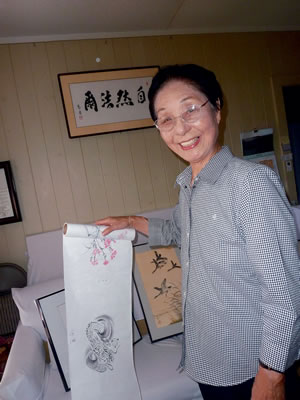Word Masters At Play
Powerful and confident voices ring out, some hiding a tremor at the publicness of it all. After all, they have the undivided attention of a roomful of 500 people or so, packed to standing room only and pouring out the door.
It’s heartening to see the laptop toting, coffee shop-squatting generation painting the air with such a vivid stream of lyrical emotion and literary genius. OK, let me gush! These HawaiiSlam poets are downright brilliant.
Sachie Saigusa
There hasn’t been this kind of fun, irreverent and utterly intelligent public display of wit and wordplay since Shakespeare.
There, I’ve said it.
And I’m not disparaging the Bard. I’m saying these young people will blow you away. In under three minutes one contender will have you doubled over, gasping to catch your breath as you wipe away ecstatic tears, while the next will have your throat in an ever-tightening vice, as you empathize with their darker challenges in life and the courage it’s taken to overcome them.
“I search my heart, and no I don’t mean I Googled it” … reads a snippet from one lovelorn guy who expresses himself from a technological bent. Another guy is so consumed by writing that he gets hot and bothered till his ink is spent. Then there’s the joy of one masochistic fella’s love-hate affair with some hella-hot kimchi soup. He waxes eloquent from the POV of his hanabata, fo’ real.
Worth standing ovations: a ridiculously funny piece on trading in an old jalopy for a camel, and a hybrid one at that! Second, a moving tribute to the various shoes people wear, the tattered and desolate ones, the heroism in a fireman’s boots. And top honors go, deservedly, to the night’s winner Liam Skilling, who didn’t just bring down the house, he rocket-launched it to smithereens with a number that turned riding a bike into an outrageously, sexy and subversive pastime.
Contestants streamed in from as near as Kalihi and Kailua and as far as Alabama, Alaska, Florida, American Samoa, the Philippines and elsewhere. The evening’s hot shot featured poets were San Francisco’s Kim Johnson and Detroit’s Natasha T. Miller, both poetry superstars. Everything Johnson uttered was carefully crafted, dazzling gold. She whipped together metaphors like nobody’s business, her love note to Jimi Hendrix from his guitar being a particular standout. Miller’s contributions were at once heartbreaking and hilarious, beautiful yet gasp-worthy.
Thursday, April 5, promises even greater heights of aural rapture when the year’s 12 top-ranking HawaiiSlam poets square off at Fresh Cafe. The slam features world poetry champ Joaquin Zihuatanejo and international touring poet Natasha Carrizosa. The $15 entrance fee helps the evening’s prevailing HawaiiSlam poets take a trip to the national slam in North Carolina later this year.
the TICKET stub
HAWAIISLAM
When: Thursday, April 5 at 8:30 p.m.
Where: Fresh Cafe
Cost: $15
More Info: 387-9664
ALSO SHOWING
Rhapsody In Ink
Japanese ink brush paintings or sumi-e (“charcoal art”) are as calming to the painter as they are to the viewer. Zen Buddhists brought the meditative art back from China and gave it a touch unique to Japan. Beginners learn strokes that will result in simple but lovely depictions of bamboo, orchids, ume (plum blossoms) and chrysanthemums. More advanced practitioners use their many brushes – thin, wide, firm, soft, tapered – to produce a range of nature settings. Bold strokes are often the telltale sign of a master at work. Someone whose brush has been tempered by years of practice doesn’t hesitate once it touches the paper.
“Each sumi-e painting requires a lot of meditative work before you start,” says sensei Sachie Saigusa through a translator. “Each painting is completed within a day because the rice paper is thin – once you touch it (with the brush), that’s it.”
The 85-year-old has been teaching the art form in Hawaii for 30 years, and has nearly 100 students enrolled in her classes at the Makua Alii Senior Center, Moiliili Community Center, the Wahiawa Community Center and the Honpa Hongwanji Mission. The students’ study “text” each week is artwork that Saigusa paints on a scroll for each student – that’s dozens of original paintings each week – as printers don’t translate the shades and subtle gradations of strokes the brush makes when dipped into varying densities of ink mixed with water. Students copy the brush strokes at home and show up for class ready to display what they’ve learned.
The students will be showing the public their best creations of the year at the annual, free sumi-e exhibition at the Honolulu Hale Courtyard April 2-13 (768-6622).
It’s the year of the dragon, so expect reproductions of the coiling, fiery creatures, as well as traditional renderings of nature and daruma characters (good luck paintings of happy men). Some of the designs feature colored paints rather than ink, and are therefore not true sumi-e, but come from the same stylistic background.
Copying the work of experts is a sign of respect, so sumi-e artists model their work after designs that have been passed down through history in replication. Yet it’s a dying art in Japan, which makes Saigusa all the more proud to be perpetuating the tradition.






